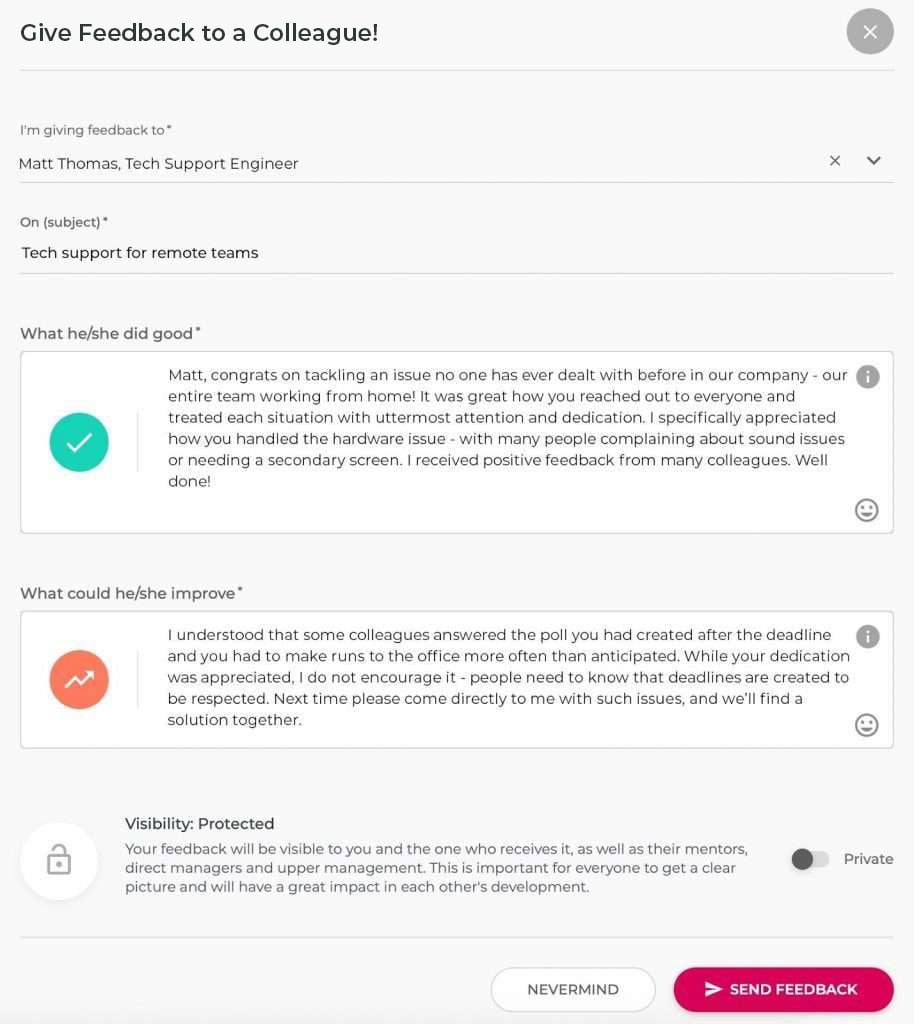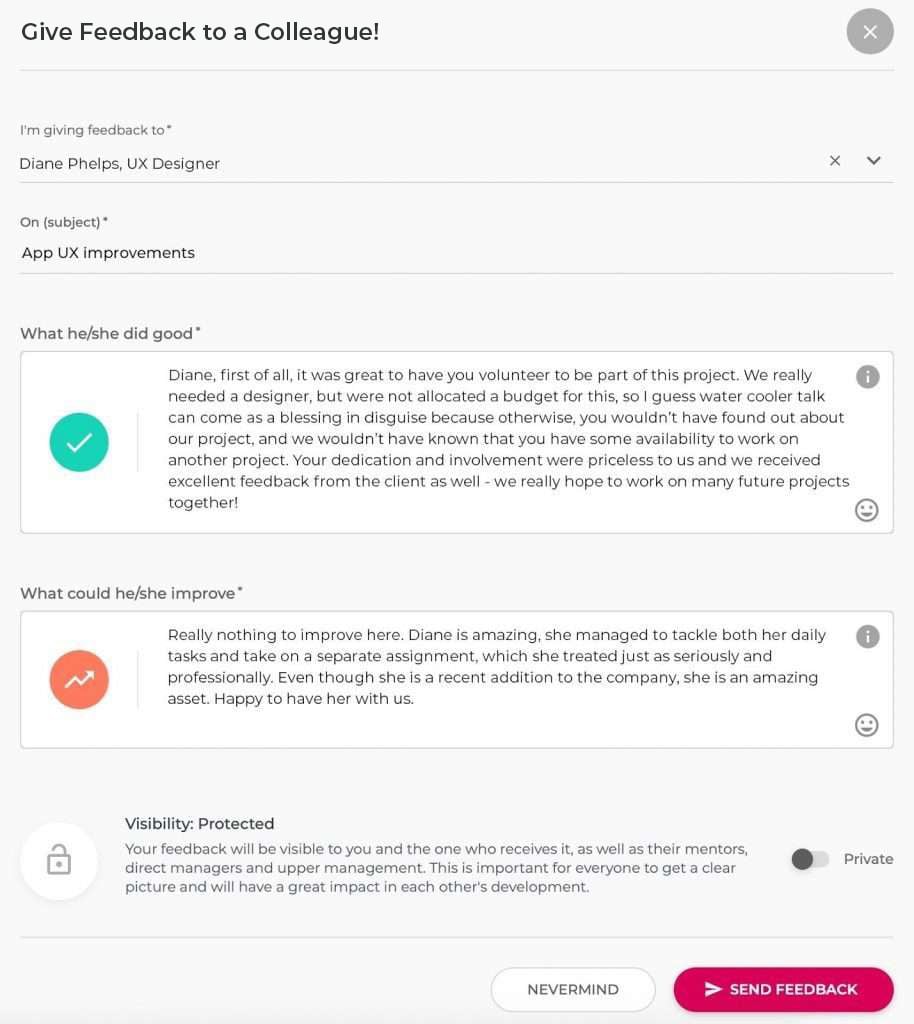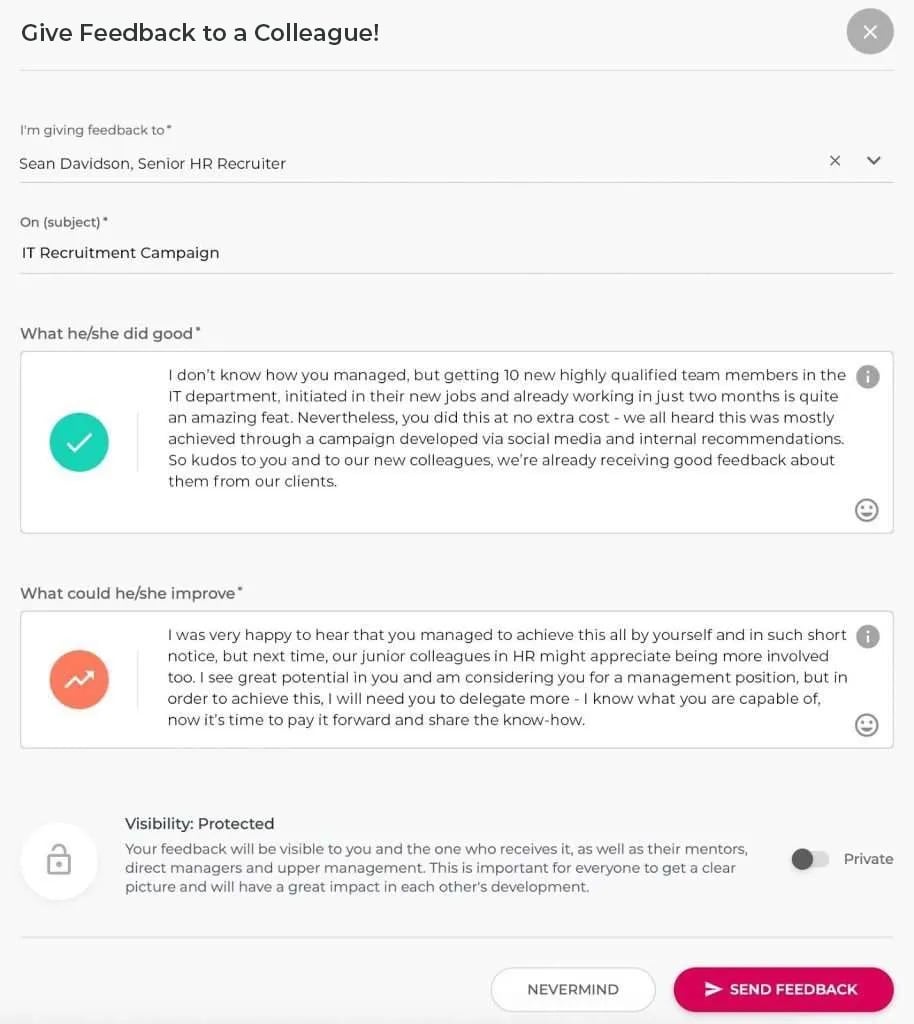SECTION
How to Give Feedback to Colleagues: Examples, Tips, and Tricks

Listen to this article:
Giving feedback to colleagues can sometimes be a dreaded affair, even when the input is positive. That has to do with the fact that we're all wired differently, and sometimes, it's just like F.R. David sang in the '80s: words don't come easy.
But writing feedback for colleagues is a skill you can hone with a bit of determination, practice, and inspiration from some handy examples. I'm here to help you channel and turn those good vibes into words.
Let's dive right in!
What is feedback?
Feedback refers to constructive criticism or beneficial information regarding past conduct or action from one person communicated to another person (or group) who can utilize that information to enhance present and future actions and behaviors.
Feedback happens when a situation responds to a behavior or action. For example, employees' reactions to their manager's feedback are referred to as "employee performance feedback."
Effective HR communication plays a crucial role in how feedback is delivered and received, ensuring that it fosters growth and aligns with company goals.
What is constructive feedback?
Constructive feedback is feedback that tries to support people by highlighting team members' areas of weakness, creating a strategy to help them overcome those flaws, and offering encouragement to stop engaging in these unfavorable behaviors.
Constructive feedback is positive since it enhances the potential of an individual, team, relationship, or environment. Constructive criticism and coaching techniques are often used to create constructive feedback.
Why giving feedback to colleagues is important?
Providing feedback to colleagues is a key factor in boosting team cohesion and driving performance. Also, it is essential for self-evaluations and identifying areas for improvement.
While studies show that employees who receive daily feedback from their manager are 3x more likely to be engaged, receiving feedback from colleagues is equally important.

Let's see what the main benefits of giving feedback to colleagues are:
Feedback drives motivation
Creating a culture of feedback contributes to employees' motivation and drive to achieve greater things. Giving your colleagues public praise for their achievements makes them feel proud and empowered, which will only motivate them to keep going on that path.
On the other hand, employees are prone to disengagement from their jobs if they don't feel like their efforts are appreciated enough. So, be sure to give praise whenever possible - either in informal conversations or formal sessions.
Feedback encourages low turnover rates
According to research, companies that encourage continuous feedback experience 14.9% lower turnover rates. Giving feedback and acknowledging people's achievements will provide the necessary validation and prevent them from searching for it elsewhere (source).
Moreover, Microsoft found that employees who feel their companies use feedback to drive change are 90% more satisfied and 89% more engaged than their counterparts.

Feedback helps improve performance
Constructive feedback is also the best motivator for improvement and increased engagement with your company's goals. Employees can only advance in their careers and thrive through a feedback culture.
Feedback encourages people to learn and grow
Continuous feedback aims to improve employee performance by promoting an open discussion of feedback. As a result of their renewed enthusiasm following the feedback, people will more likely come up with original and imaginative solutions to issues.
Use the feedback loop to establish a continuous cycle of learning and development.
Being anxious about giving feedback is normal
Rigid definitions tell us feedback is the information sent to an entity, be it an individual or a group, about its prior behavior so that it can adjust course. However, pompous words aside, you know feedback involves:
- Speaking your mind;
- Detailing your opinions;
- Giving praise or criticism;
- Owing up to it all.
Clearly, it's no walk in the park. It's no wonder most people would love to skip providing feedback for a colleague and retreat to their shells.
But making yourself heard is vital at work. So vital, companies now aspire to have an authentic culture of feedback. This way, every team member is trained and given the tools necessary for continuous feedback loops.
Let's take it from an expert. Elena Ungureanu is a Senior HR Specialist at Mirro (remember the name, we'll come back to it) and a big believer in constructive feedback for colleagues.
So here's her advice to you:
"Feedback is a way of building trust out of a foundation of honesty. It's essential to recognize the peers on your team and help them understand their strengths and potential weaknesses. Time and time again, we've discovered that's the perfect recipe for growth. I'd encourage you to be honest, give examples, and stay empathetic when providing feedback to colleagues. Have a candid delivery, sure, but also consider how you'd feel if you were on the receiving end of your words and adjust accordingly."
Now that Elena got us in the right mindset for giving feedback to a colleague, let's look at other techniques you have at your disposal for building your observations.
How to give better feedback to your colleagues in nine steps
I know, I know. Nine steps might sound like a lot, but I guarantee you're already doing some of them without even realizing it. So let's see what else you could add to your arsenal.
1. Focus on professional aspects
When you're in a professional setting, stick to facts, examples, and lessons learned. Steer clear from dragging personality traits into the mix, and it should go without saying, but don't be rude.
There's a fine line between being open to feedback or taking it personally, so make sure you don’t make the receiver all defensive.
❌ “Your superficial nature almost cost us a few important slides from the eCommerce presentation.”
✔️ “It would have been more efficient to limit small talk to just 5 or 10 minutes at the beginning of the meeting. This way, we would have had enough time to go over all the slides in our eCommerce presentation. However, we’ll have the chance to apply this in our next meeting with the client.”
2. Get specific
Imagine getting a comment like, "Your work needs improvement." That's way too broad to even qualify as feedback.
If you want to give your opinion, make sure to stick to specific tasks or projects. Otherwise, you risk leaving your team member dazed and confused.
On the other hand, a remark such as "Your presentation needed figures for each key objective to paint the whole picture" hits the spot and gets your point across.
3. Highlight the positives
While the end goal of constructive feedback is to help your peers improve, that doesn't mean your feedback should be a collection of negative episodes.
You also need to acknowledge and highlight everything that went well, as giving positive feedback to colleagues is a must. This not only helps put the other person at ease but it also sets the tone for future sessions. After all, feedback loops should not be feared.
4. Praise publicly, scold privately
You've probably heard this one before, as joy and pain are universal, but it's a good rule for feedback.
Be generous with your appreciation and go for large forums if appropriate, but keep anything potentially critical for 1:1 discussions. You wouldn't want to embarrass someone publicly and even risk hurting their feelings or putting them on the spot.
5. Give your feedback freely
You don't have to be in a management position to inspire people around you and drive change. If you believe in the power of positive feedback for colleagues, you can start your movement and offer your input.
Be the first, set the tone, and show your team how it's done. Favor diplomatic and balanced takes over-aggressive or sarcastic comments, delivered with a superior attitude.
6. Ask for feedback as well
To fuel your growth and highlight any blind spots, ask for feedback as well. Allow yourself to learn how others perceive you and your projects and gather valuable insights. Dare to make yourself vulnerable, deepen your relationships at work, and take your continuous learning skills to the next level.
7. Turn giving feedback into a routine
Realistically speaking, there's no need to wait until the end of a quarter to give someone feedback. When incorporated into the weekly or bi-weekly routines, input becomes less scary and becomes a habit.
Let's not forget that company cultures revolve around shared traditions, habits, and attitudes. So, it's in your power to create shared experiences around giving and receiving feedback, all positively and respectfully.
8. Pay attention to the things you say
Let's take the following situation:
Linda is an experienced Software Developer. She's recently been paired with her new colleague Sam for code-reviewing sessions.
One day, before they begin their meeting, Linda tries to be funny and calls Sam's code "sloppy." However, her joke doesn't land well.
Sam, who looks up to Linda, is affected by her comment. Since she's been with the company longer than him, he considers her to be the team's voice.
Without further guidance and in light of the comment, Sam feels underappreciated, starts underperforming, and considers looking for another job.
The lesson here is that you should always mind your words and ensure you don’t land at the receiving end of negative feedback examples for colleague queries.
Keep it professional and let familiarity arise naturally. Don’t force it.
9. Look for people with growth mindsets
People with growth mindsets are invaluable to organizations. They believe feedback and a winning strategy for improving their skills are crucial to their jobs. And the good news is they're usually easy to spot during recruitment processes.
To support their growth, ensure they constantly have access to training sessions and other developmental opportunities.
All these strategies should be included in your company's feedback framework. Read our article to learn how to build and integrate a framework tailored to your organization's needs.
And now, let's take a look at some examples encompassing everything you've learned so far. They will make your life easier the next time you're asked to provide your feedback.
Positive feedback examples for colleagues
Since time isn't always on your side, I've prepared some feedback templates you could use as inspiration when giving feedback.
Lara, the advertising hotshot

I'm giving feedback to: Lara Johnson, Campaign Manager
On: June's Advertising Campaign
What she did well:
Lara, congratulations on wrapping up this challenging project!
I particularly appreciate your dedication and communication skills. The fact that you managed to handle all communication during the briefing and creative process with the agency didn't go unnoticed.
Things were a bit touch and go when we had to deliver all the materials a week earlier than anticipated, and yet, you still managed to rally up the troops and get it all done.
What she could improve:
The KPIs for the campaign were above market medians, and they proved unrealistic in the end. So for our next project, let's adjust the projections and set more attainable milestones.
Matt, the efficient Tech Support Engineer

I'm giving feedback to: Matt Thomas, Tech Support Engineer
On: Tech support for remote teams
What he did well:
Matt, congrats on tackling an issue no one had ever dealt with before in our company – our entire team having to work remotely for a month!
It was incredible how you reached out to everyone in the office and treated each case with your utmost attention and dedication.
I appreciate how seamlessly you handled all the hardware issues. Thanks to your expertise and overnight deliveries, I've received many notes from colleagues delighted they got their home office set up in no time. Well done!
What he could improve:
Since some colleagues didn't stick to your deadline and informed you about their tech needs late in the game, I know you had to work overtime several times. While your dedication is appreciated, we don't encourage burning the midnight oil and letting tasks affect your personal life.
Please let me know if you'd like to attend a training on setting clear boundaries and learning to say no.
Diane, the UX champ

I'm giving feedback to: Diane Phelps, UX Designer
On: The checkout flow redesign
What she did well:
Diane, judging by conversions and other metrics, the checkout flow redesign is a major success, and you've made it all happen!
Your dedication and involvement were priceless to the team. Plus, we've also received excellent feedback from our customers.
Thanks to your efforts and teamwork, we have already reached our targets for the quarter. So now, we finally have the time to develop the visual interactions from your list.
What she could improve:
I know there are days when you have to juggle high-priority tasks and get Product Managers bugging you, asking you to handle their project first.
Would you please start keeping track of these situations so that we can discuss them together? Of course, you shouldn't have to make such decisions, and I want to be sure you're not under too much pressure.
Sean, the all-star recruiter

I'm giving feedback to: Sean Davidson, Senior HR Recruiter
On: DevOps Recruitment Campaign
What he did well:
I don't know how you managed it, but headhunting and signing four highly qualified candidates for the DevOps team in just six weeks is quite a remarkable feat. Even more impressive is that you did it all by encouraging introductions and recommendations from people already in the department.
What he could improve:
During our previous 1:1s, you mentioned your to-do list can sometimes grow out of control. I would encourage you to focus solely on priority projects for the next months and delegate everything else on your desk. Please let me know if you think we should schedule any training to facilitate this new workflow.
Now that you're all equipped to deliver feedback, it's time to think about the best software to use. And I have just a suggestion for you.
Drive your culture of feedback with Mirro
Mirro is an easy-to-use employee feedback software with a powerful module for giving ongoing feedback.
Built to take all the pain from asking and receiving input, it normalizes feedback loops and helps you build a culture based on trust, openness, and transparency.
You can use Mirro to:
- Ask for your peer's perspective on your projects;
- Offer your feedback freely;
- Show your appreciation for colleagues for doing great work;
- Share your expertise and highlight what could be improved;
- See your evolution through time.
Bogdan Ionita is Mirro's Product Manager, and he can tell you more about how using a platform for feedback can transform your career and increase your productivity.
"In an ideal world, all companies would get to enjoy face-to-face feedback sessions. However, that's not always possible, so Mirro helps teams encourage and manage their input flows. Feedback can be a matter of habit, psychological safety, timing, and context. So Mirro handles all these puzzle pieces and lets companies foster transparency and accountability. Whether you want to mark an achievement, a team event, or a new milestone, Mirro is there to help you gather your thoughts and turn them into valuable, constructive opinions. What's more, the platform lets users ask for perspectives, driving the feedback process themselves to create a sense of safety and togetherness. In the end, that gets translated into more willingness to share and to accept authentic, human perspectives."
Start your Mirro demo today if you're ready to say goodbye to all the red tape and awkwardness around providing feedback to your colleagues.
Let powerful insights inform your next move, and put all those feedback templates to good use!







